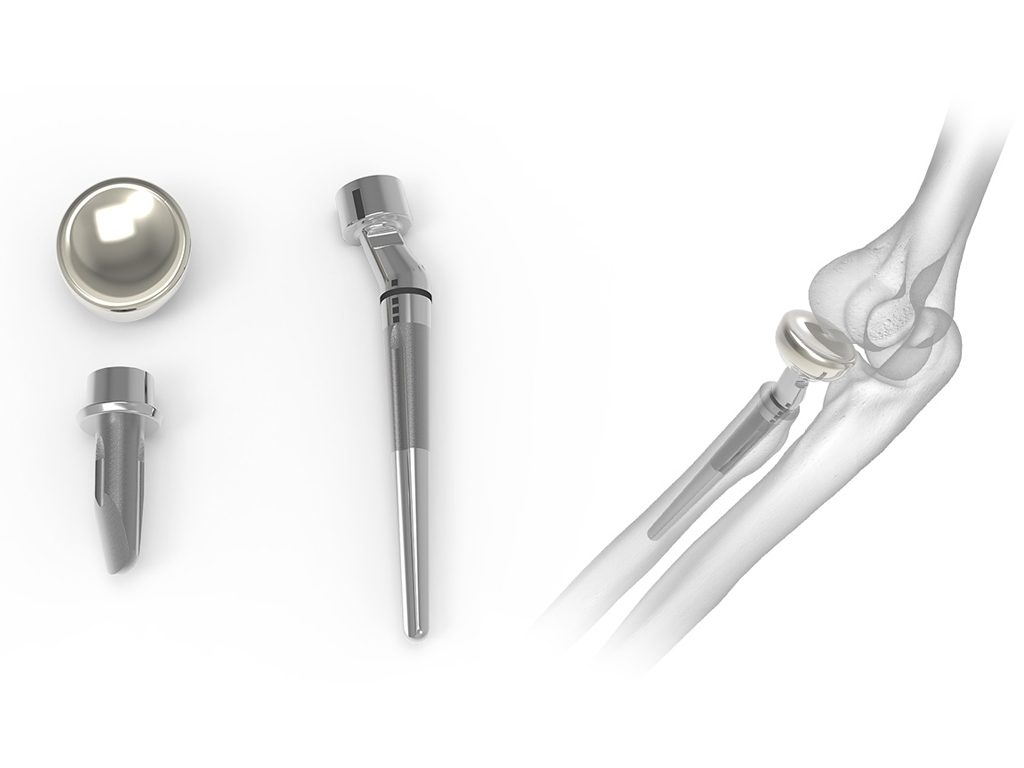
Anatomic Radial Head Solutions
March 27, 2018
Overview The Acumed Anatomic Radial Head System is designed to provide an anatomic implant to replace the patient’s native radial head. Designed in conjunction with Shawn W. O’Driscoll, Ph.D., M.D., the system includes 290 head and stem combinations including standard stems, long stems, an anatomically shaped radial head, and system-specific instrumentation to help streamline the surgeon’s experience in the operating …
Overview
The Acumed Anatomic Radial Head System is designed to provide an anatomic implant to replace the patient’s native radial head. Designed in conjunction with Shawn W. O’Driscoll, Ph.D., M.D., the system includes 290 head and stem combinations including standard stems, long stems, an anatomically shaped radial head, and system-specific instrumentation to help streamline the surgeon’s experience in the operating room.
In addition to the Anatomic Radial Head System, the set may include the Acutrak 2 Mini and Micro instruments and the Locking Radial Head Plate System at the base of the tray to provide multiple solutions all in one set.
Key Features
- The First and Only Anatomic Radial Head:
Originally released in 2006, the prosthesis has been used in thousands of radial head procedures over multiple system generations and product line extensions. More than a decade of research and experience has influenced key refinements to the anatomic properties of the system. - New Anatomic Design Features:
– Contouring of the medial side of the head has been further defined to track against the radial notch of the ulna2.
– The dish depth increases with head diameter, which is designed to help improve radiocapitellar wear characteristics over the current-generation Acumed Anatomic Radial Head.1
– The implant’s medial surface is contoured to better replicate the lateral trochlear ridge facet, which may help avoid cartilage erosion.2
– With the annular ligament in mind, a more defined S-shaped contour has been added to the lateral side of the radial head prosthesis.
1. Bachman DR, Thaveepunsan S, Park S, Fitzsimmons JS, An KN, O’Driscoll SW. The effect of prosthetic radial head geometry on the distribution and magnitude of radiocapitellar joint contact pressures. J Hand Surg Am. 2015;40(2):281–288.
2. Sahu D, Holmes DM, Fitzsimmons JS, Thoreson AR, Berglund LJ, An KN, O’Driscoll SW. Influence of radial head prosthesis design on radiocapitellar joint contact mechanics. J Shoulder Elbow Surg. 2014;23(4):456–462.
Anatomic Radial Head
1. 20-28 mm left and right specific heads.
2. The dish depth increases with head diameter, which is designed to help improve radiocapitellar wear characteristics over the previous generation Anatomic Radial Head.2
3. The implant’s medial surface is contoured to better replicate the lateral trochlear ridge facet, which may help avoid cartilage erosion.1
4. Contouring of the medial side of the head has been further defined to track against the lateral side of the ulna.
5. With the annular ligament in mind, an S-shaped contour was built into the lateral side of the radial head prosthesis.
Long Stems
1. Hashed Laser Marks: Indicate proper alignment with the lateral aspect of the radius when the forearm is in neutral position. Lister’s tubercle may also be used as a landmark for laser mark orientation.
2. Partially Grit Blasted Stems: Intended to promote proximal bony ongrowth.
3. Resection Length: Four long stems accommodate resection lengths from 19 mm to 28 mm. The Long Stem Resection Guide is used to measure the length of resection, which corresponds to stem diameter.
4. Insertion Depth Laser Mark: Corresponds to the stem diameter and proper insertion depth based on equivalent level of resection.
5. Stem Length: Four long stems range from 50 mm to 65 mm in length (5 mm increments) and 6 mm to 12 mm in diameter (2 mm increments).
Reamers
The Anatomic Radial Head System has evolved from the use of broaches to that of reamers for canal preparation. Reamers allow for a 1 mm larger stem diameter and may decrease risk of iatrogenic fractures of the radius compared to broaches.3
Customized Instrumentation
Stem Removal Tools – The ARH Removal Tool Shaft threads into standard and long stems to aid in stem removal during primary or revision surgery. The Cross Bar may be inserted through the ARH Removal Tool Shaft handle and be used as a surface for tapping the stem out with a mallet.
Radius Retractor – Designed to help elevate the radius, this tool may assist during reaming, trialing, and insertion of the implant.
Citations
1. Sahu D., et al.,Influence of radial head prosthesis design on radiocapitellar joint contact mechanics., J Shoulder Elbow Surg. 2014.23(4): 456-462. doi: 10.1016/j/jse. 2013.11.028.
2. Bachman DR, Thaveepunsan S, Park S, Fitzsimmons JS, An KN, O’Driscoll SW. The effect of prosthetic radial head geometry on the distribution and magnitude of radiocapitellar joint contact pressures. J Hand Surg Am. 2015;40(2):281-288.
3. Shukla, D.R., et al., Canal preparation for prosthetic radial head replacement: rasping versus reaming, J Shoulder Elbow Surg. 2013. 22(11): 1474-9